My ride to Los Angeles.
Northbound Coast Starlight awaiting departure at 10:10
AM, with arrival in Seattle tomorrow night at 8:12 PM.
Boarding on the Coast Starlight on Track 10.
An excellent reason to ride the Starlight is the first
class lounge parlour car.
Number 14 pulled
out on time at 10:10AM and now it was time to walk
through the station and on to Chinatown.
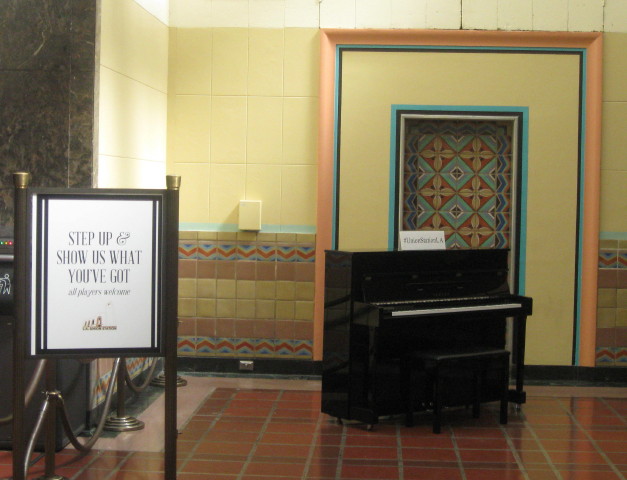
Alright you ivory ticklers, entertain us.
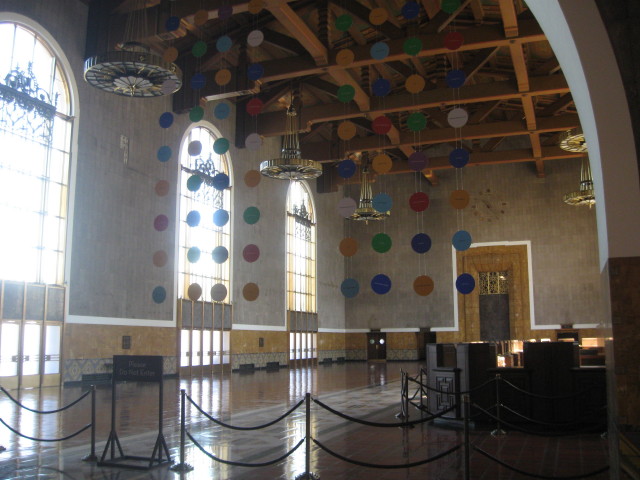
Ticketing room.
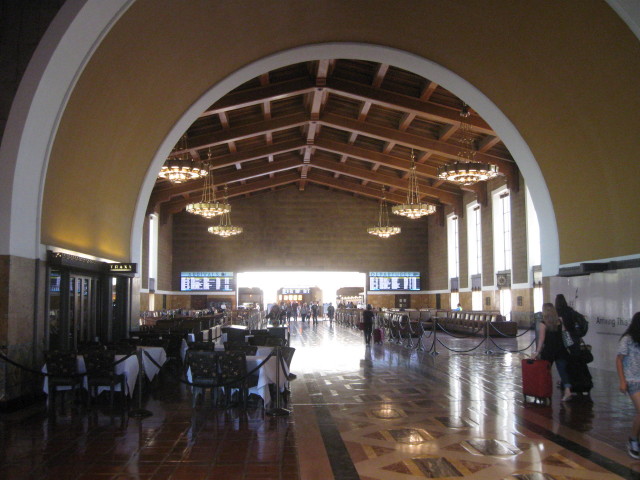
Waiting room looking toward the tracks and
platforms. Little gift shop has been removed.
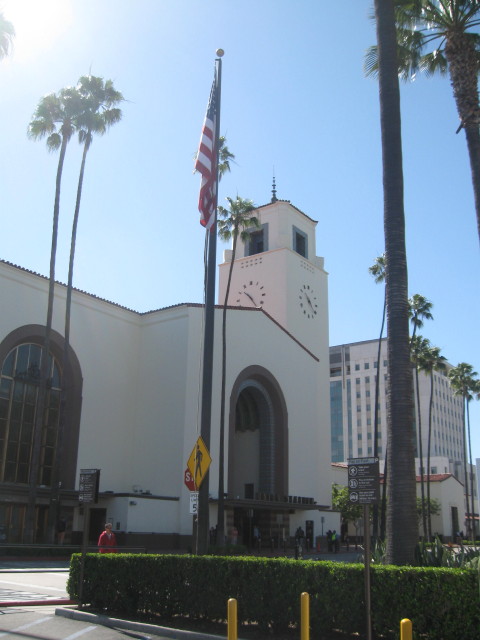
Union Station front.
Walking to N.
Alameda St and then up to Cesar Chavez Avenue and
then west on Cesar Chavez to North Spring St to my
first stop. The King Hing Theatre.
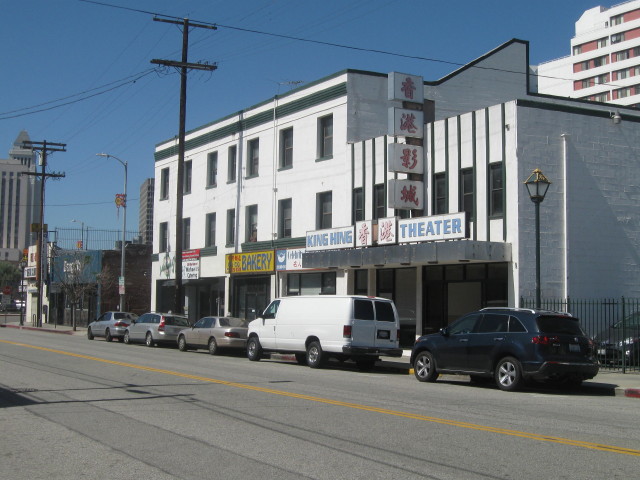
King Hing Theater, 647 N. Spring Street.
The
375-seat King Hing Theatre, originally named
the Sing Lee Theatre, opened in 1962. It was
designed by Gilbert L. Leong, a native
Angeleno and the first Chinese American to
graduate from the USC School of Architecture.
The theater was a popular destination for the
community, helping to make Spring Street a
thriving local hub between the 1950's and the
1970's. The King Hing Theatre showed Chinese
language films and hosted live performances,
including Chinese operas. It stopped operating
in 2001.
This
was the first stop for tour goers. Inside a
program was presented to give some history
and background of Old and New Chinatown.
Among the speakers were Sara Lann, Director
of Education, LAC, plus a docent from the
Chinese American Museum, and then
former council member Mike Woo. Some notes
from the program.
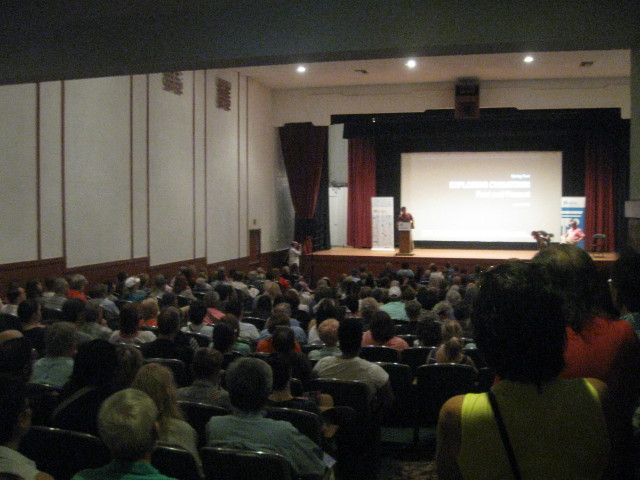
Full house in attendance for start of tour
presentation.
Wedged between Elysian Park to the north,
and Lincoln Heights and Echo Park to the
east and west, Los Angeles' Chinatown
spans a little less than a mile. Along
with iconic symbols of classical East
Asia-tiled roofs, red lanterns, and
wishing wells-exists the history of one of
Los Angeles' oldest neighborhoods.
The streets and parcels
that formed the community's center were
plotted in L.A.'s first official city survey
in 1849, one year before California became a
state. No other area of the city, except
downtown, was mapped out before this
location. Photographs taken in the mid-to
late nineteenth century show modest houses
surrounded by wooden fences, separating wide
lots from their neighbors and the dusty
road.
What is now know as
Chinatown wasn't the first in Los Angeles.
The first permanent settlement of Chinese
immigrants centered around El Pueblo de Los
Angeles, the city's birthplace. Most of
these residents were miners and laborers,
men from the Guangdong province who traveled
to California in search of better
opportunities. Many found employment working
on the railroads.
From the outset,
Chinese Americans faced discrimination on a
systemic level, evidenced by the jobs they
were allowed to have, the places they were
allowed to live, and the spats of
violence their community endured from
others. Still, Chinese immigrants continued
to settle and prosper in Los Angeles. This
first Chinatown became a thriving hub of
Chinese residences and businesses complete
with schools, temples, theaters, and
restaurants. But the denial by city
officials of public services to the Chinese,
such as sewer systems, paved roads, and
electricity, created a health risk. A
proposal to raze the neighborhood in favor
of a new railway terminal to be built on
this site was issued in 1913; over the next
decade, anti-Chinese sentiment and
excitement for Union Station led to the
neighborhood's ultimate destruction. At the
time of what is now known as Historic
Chinatown's condemnation in the 1930s, there
were close to 3,000 Chinese Americans living
in Los Angeles, most of whom faced
displacement.
Today's Chinatown
was born as a destination as well as a
community. Its founders envisioned a place
that would serve and protect local Chinese
American residents, as well as draw visitors
to partake of its unique offerings. For many
tourists, Chinatown's cuisine was the
biggest draw. When Chinese American
migration to the San Gabriel Valley began in
1970s, many of the massive dim sum palace
restaurants moved with them. The ones that
stayed struggled to keep afloat through
decades of economic decline.
In recent years,
Chinatown had attracted new business and
development that has brought new visitors to
the area. An influx of art galleries, along
with young, trendy eateries, offer new
options alongside Chinatown's established
shopping and dining institutions.
And speaking of trendy
eateries, it was lunch time. So I headed to
Ord Street and then down to Philippe The
Original. I left the presentation a few
minutes early to try to beat the crowd to the
lunch counter. Yes it was crowded, but the
wait was only a short ten minutes before I
could order my beef stew, coleslaw and
lemonade. I sat in the little room with the
model railroad display. Another reason to eat
at Philippe's.
After my nice repast it was
time to start touring. Walking out the door
and turning right, I went up Ord St. to my
next stop at Ord and Broadway.
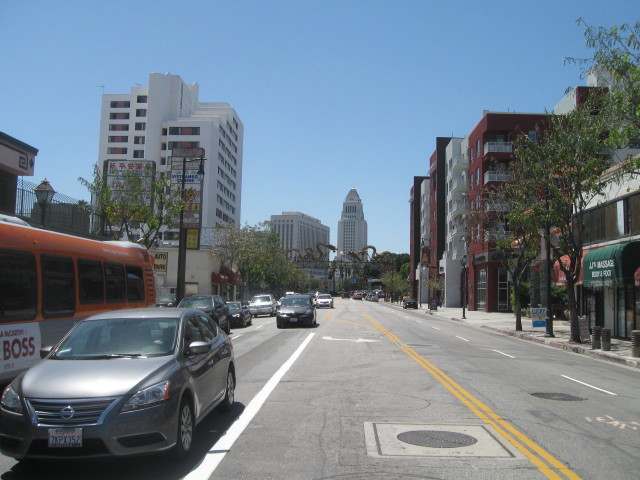
Broadway and Ord Street.
.
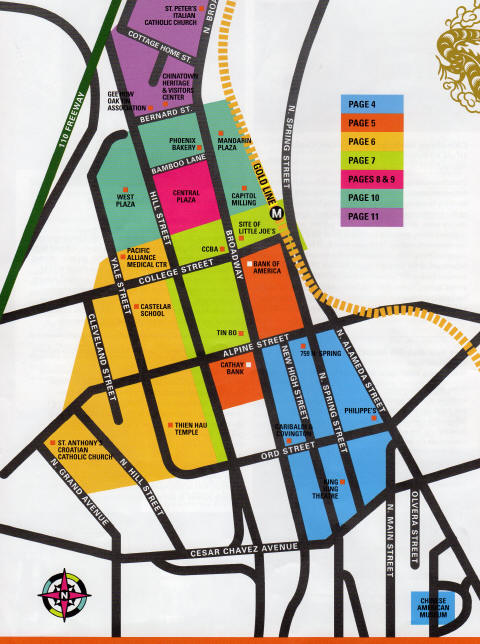
map courtesy of Los Angeles Conservancy.
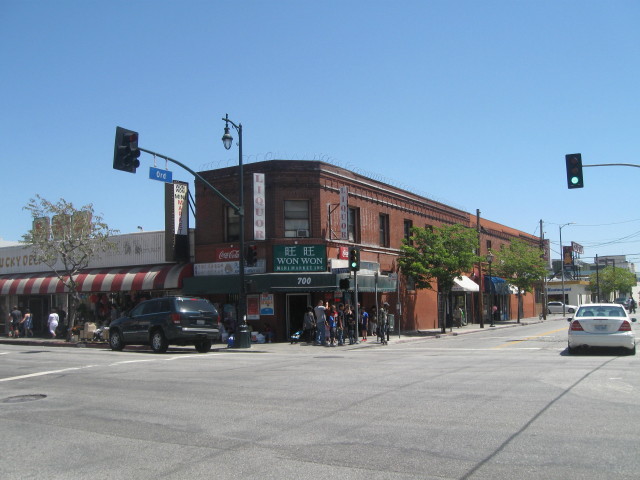
Garibaldi Building, Northeast corner of Broadway and
Ord Street.
1906, R.B. Young
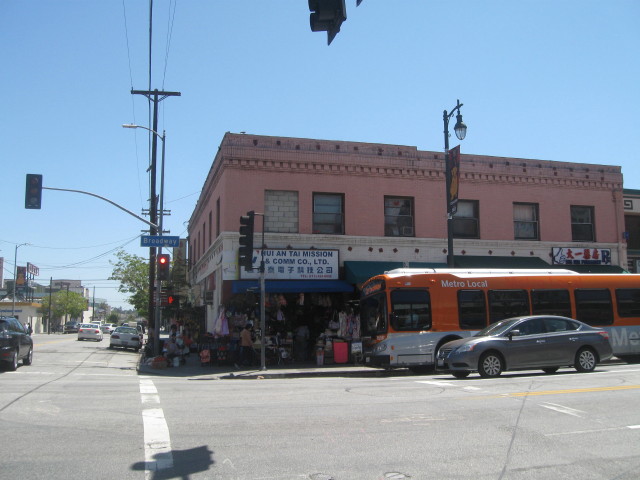
Covington Building, Southwest corner of Broadway and
Ord Street.
1913, Hudson & Munsell
The Garibaldi
and Covington buildings, located in the heart of
what was once Little Italy, are among the last
intact commercial buildings associated with
Italian ownership in the neighborhood.
The Garibaldi
Building housed S. Peluffo & Sons grocery for many
years. Italian immigrant Stephen Peluffo was one of
the city first wholesale grocers and also owned a
winery. The Covington Building likewise catered to
businesses owned by Italian immigrants. Both buildings
had apartments on their second floors.
Continuing on Ord St. to Hill St.
At Hill turned right and headed north to Alpine Street
then left Alpine to Yale Street. Going up Ord Street
would mean a steep climb up the hill. The Alpine
Street was a gentle climb.
After turning left, I could see my
next stop. The Thien Hau Temple, 756 Yale Street.
2005.
Thien Hau Temple was built by the
Camau Association of America, a benevolent association
that serves immigrants from Vietnam along with other
East Asian populations. A Taoist temple, Thien Hau
Temple is dedicated to Mazu, the goddess of the sea
and patron saint to sailors and fishermen. Many
residents of Chinatown came from communities in
southeastern coastal areas of China, which, along with
Vietnam, have strong ties to the ocean. Other shrines
in the Thien Hau Temple are dedicated to the warrior
Guan Yu and earth god Fu De.
Chinatown saw waves of immigrants
from Taiwan and Hong King after the repeal of the
Alien Quota Act in 1965. After the Vietnam War, a
flood of Indochinese refugees including Vietnamese of
Chinese origin as well as ethnic Vietnamese,
Cambodian, Laotian, and Thai Immigrants arrived,
growing Chinatown's population and diversity. Today,
the culture of Chinatown is a more inclusively Asian
one, as seen in institutions such as Thien Hau Temple,
where people from multiple backgrounds come to pray.
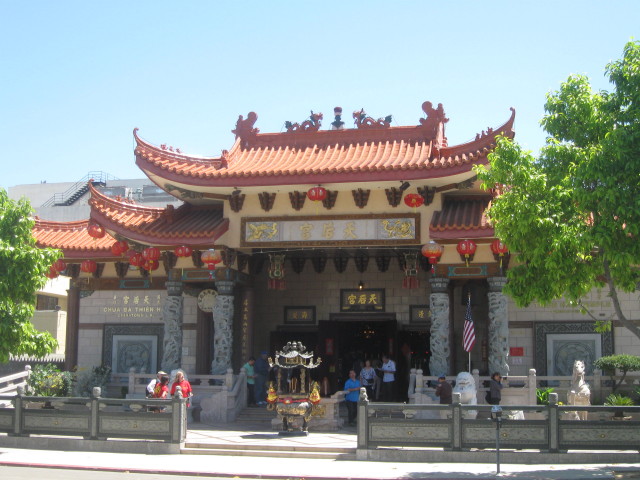
Thien Hau Temple, 756 Yale Street, 2005
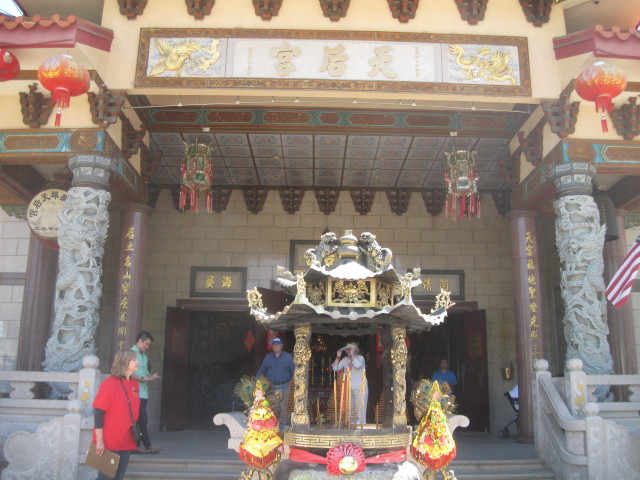
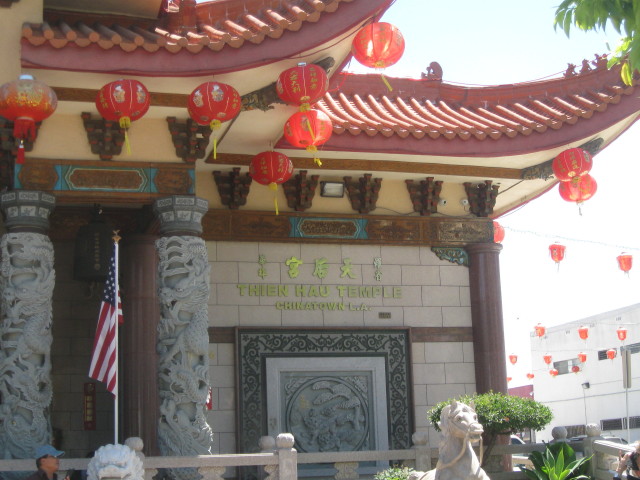
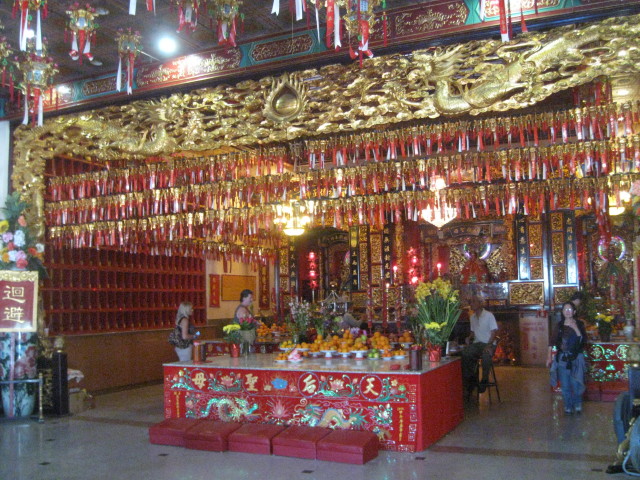
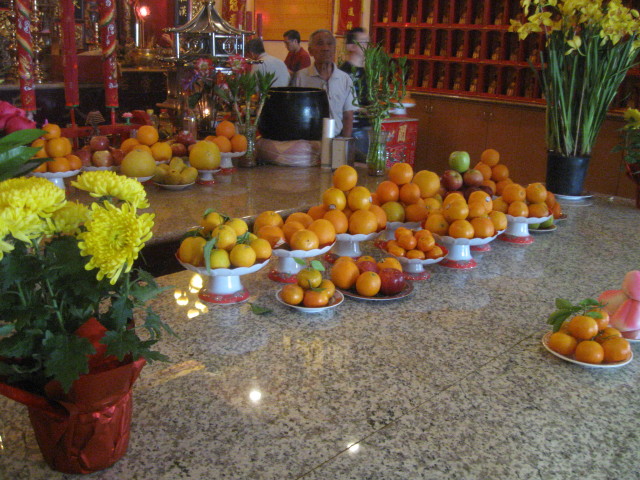
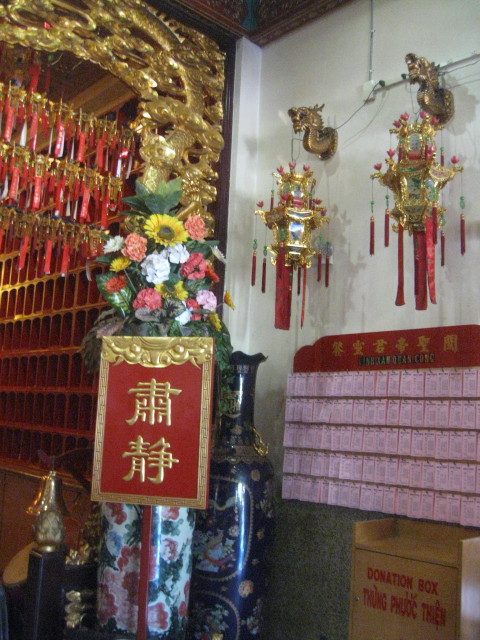
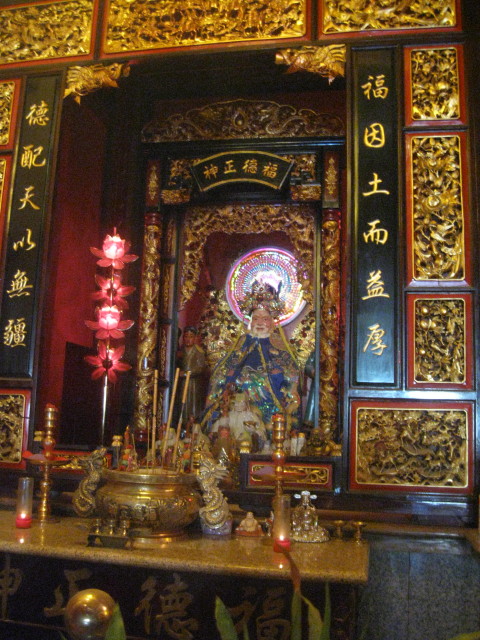
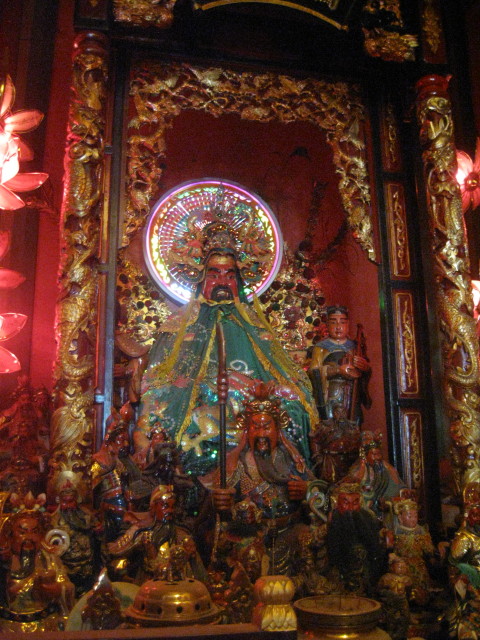
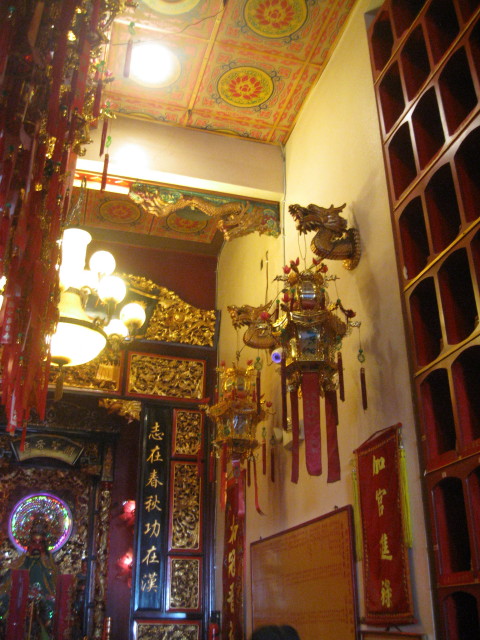
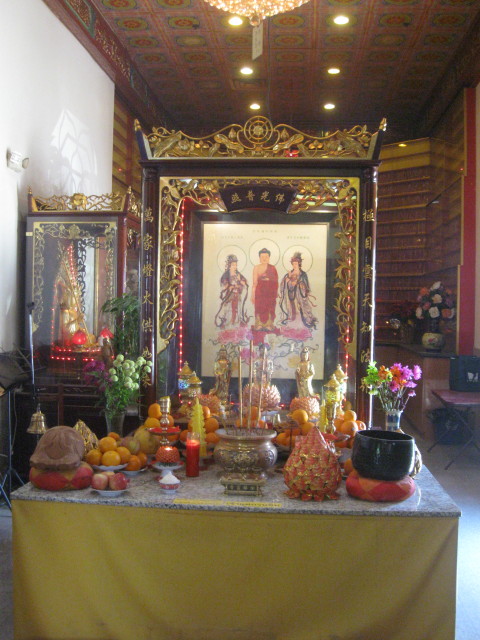
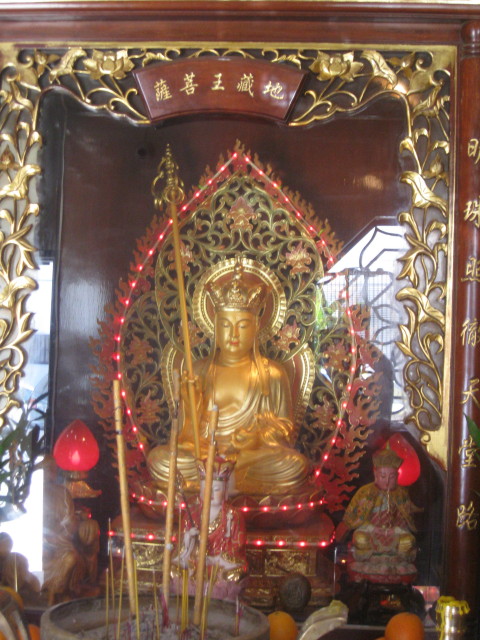
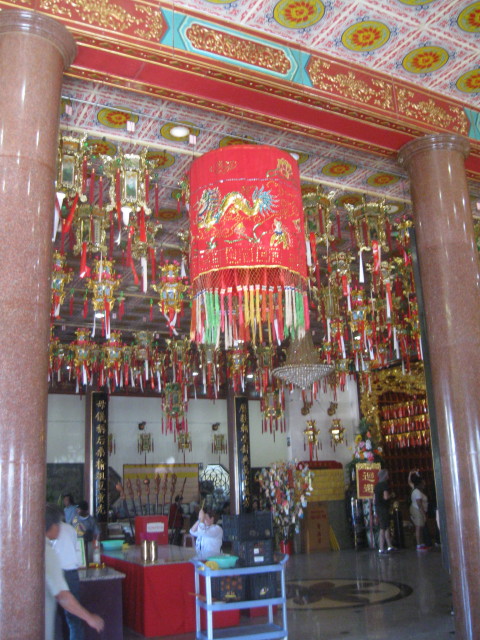
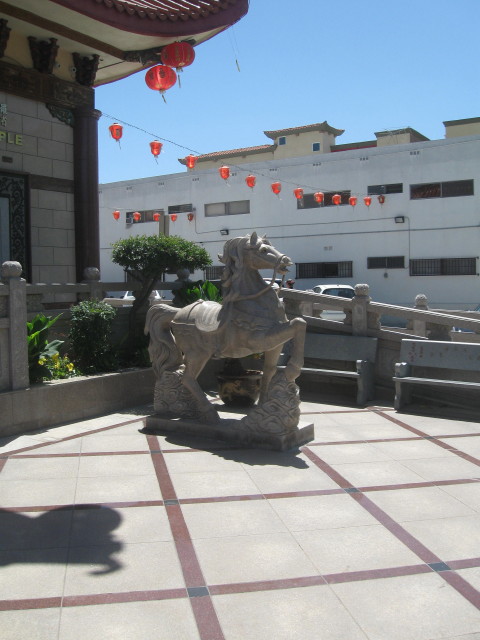
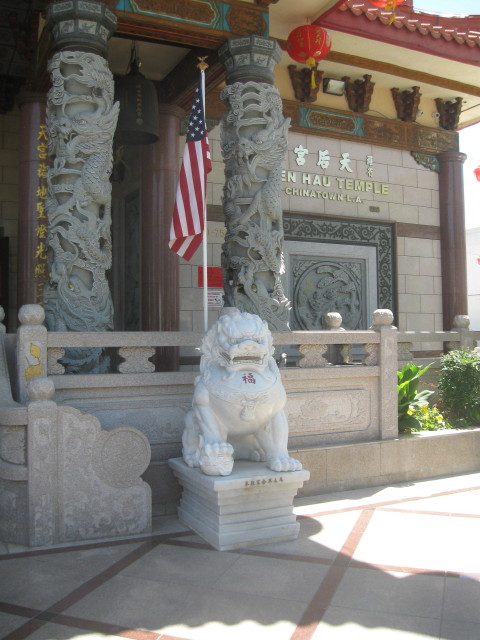
Leaving the
temple I walked back to Alpine and then back to
Hill Street. Going north on Hill Street, I arrived
at the next stop.
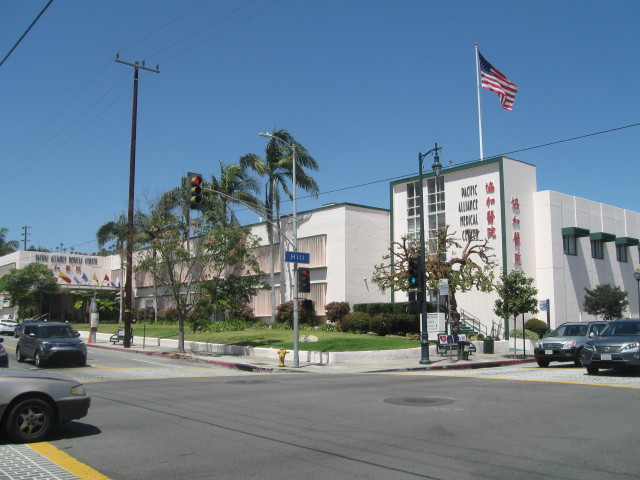
Pacific Alliance Medical Center
531 W. College Street
Originally the French Hospital.
Constructed
by the French Society, the French Hospital was
founded in 1869. It offered healthcare and
medical services to French American citizens
and newly arrived French immigrants, as well
as to the greater community regardless of
nationality, race, religion, or gender. Now
known as the Pacific Alliance Medical Center
(PAMC), it is the second-oldest hospital in
Los Angeles. Still on its original site, PAMC
has been remodeled several times, most
recently in the 1960s. A visible sign of the
hospital's history is the statue of Joan of
Arc at the corner of Hill and College Streets,
a reminder of the French community's presence
in the neighborhood's early days.
Continuing
north on Hill Street is my next stop: West Plaza.
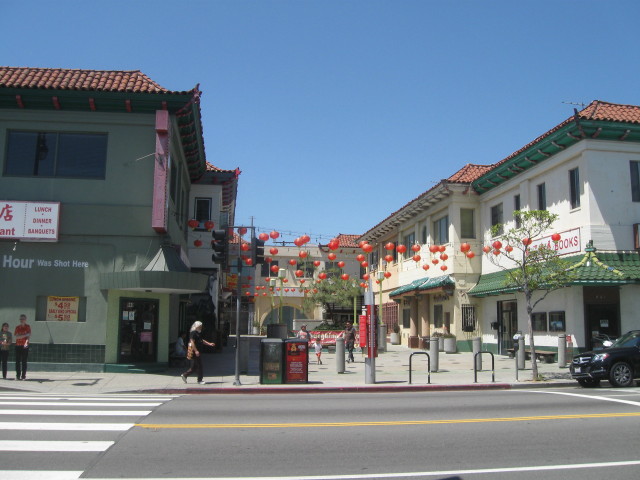
West Plaza, Hill Street between Bernard and
College Street.
Located across Hill Street from the Central
Plaza, the West Plaza was developed after
World War II and opened in 1948. The design of
the complex features Chinese elements, such as
green tile roofs with upturned eaves, and a
wishing well. The overall aesthetic of the
West Plaza is more modern in style and more
subdued in decoration than Central Plaza. It
was intended to cater to the neighborhood
rather than to tourists. Across Hill Street is
the West Gate.
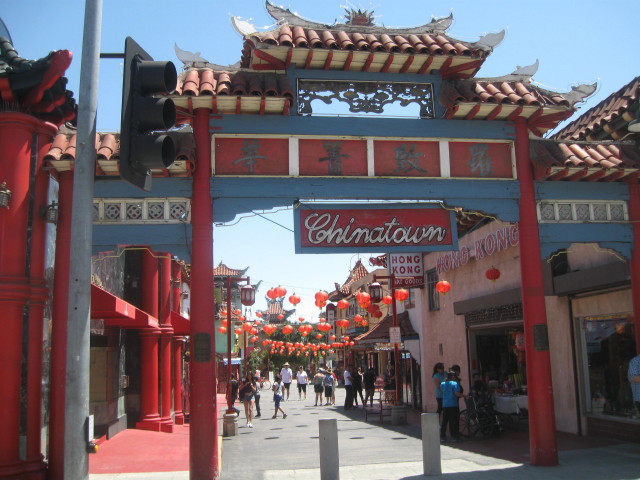
West Gate.
Two of
the most iconic structures in Chinatown
are the welcome gates leading to the
Central Plaza on either end of Gin Ling
Way. The West Gate (on Hill Street) was
erected in 1938 as part of the initial
development of the Central Plaza. Its
traditional design included 150-year old
camphor wood from China. The Chinese
characters translate to "Cooperate to
Achieve."
Continuing north on
Hill Street to Bernard Street and arrived
at my appointed duty station. I had
arrived a little early and the site
captain Cindy said it was OK to take off
and come back in 30-40 minutes. I decided
to walk down Broadway. I was going to do
it later on the way home but now I could
get inside the Cathay Bank while it was
still open. I walked down Broadway to
Alpine Street and would return taking time
to return.
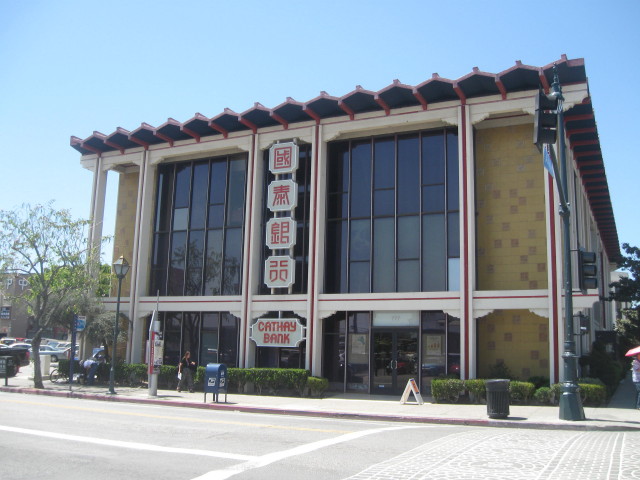
Cathay Bank
777 N. Broadway
1966, Eugene Kinn
Choy & Associates
Cathay Bank was born of necessity:
in 1962, Chinese Americans in Los
Angeles faced discrimination by
financial institutions and
businesses that often denied them
loans and other banking services.
Founded by prominent businessmen in
the Chinatown community, Cathay Bank
was the first Chinese American bank
in California and the first to
specifically address the needs of
the rowing Chinese American
population. Its commitment to
equality is reflected in its motto:
An Open Door to All. Cathay Bank has
since opened branches throughout the
nation and world.
Cathay Bank was
designed by Eugene Kinn Choy. A
graduate of USC's School of
Architecture. Choy became the second
Chinese American to join the
American Institute of Architects.
Other buildings of Choy's in
Chinatown include Broadway's Chinese
Consolidated Benevolent Association
(CCBA) and the Jin Hing Jewelry
Store on Bamboo Lane. Like the CCBA,
Cathay Bank is a hallmark of Modern
design combined with traditional
Chinese architectural elements.
Choy's use of the International
Style of Modern architecture is
augmented by the four Chinese
characters running vertically down
the front facade of the building,
while the roof evokes the classical
wood roofing of Chinese structures.
Choy specifically incorporated these
details to honor the request of
Cathay's founders, who wanted the
banks design to reflect their
cultural heritage. The convergence
of traditional Chinese custom and
modern innovation seen in Chouy's
work is an apt reflection of the
Chinatown community.
As no photography
was allowed, I have no pics of
inside. One interesting item were
the counters where you stand to fill
out your paper work before heading
to the teller window's,
embedded in the counter's top was
an abacus. There were several
in the lobby. Were they the earliest
binary computers? The bank hostess
were handing out nice tote bags. I
asked if there were any free samples
included. But Alas, No photography,
No free samples. But of course I
left in a huff and walked up
Broadway.
My next stop was
a quick walk through and look see.
Tin Bo Inc,
841 N. Broadway.
One of
many excellent herb stores in
Chinatown, Tin Bo carries a wide
selection of teas and herbs, including
what are considered the "big three"
health supplements in Chinese
medicine: ginseng, reishi mushrooms,
and deer antler. They are believed to
improve energy levels, body function,
and longevity. Chinese medicine and
apothecaries such as Tin BO were a
part of Chinatown from its earliest
days: Chinese companies imported
specialty herbs for their workers, and
Chinese groceries often stocked
medical ingredients alongside food
items.
I walked to the
next block and the location of the
Chinese Consolidated Benevolent
Association.
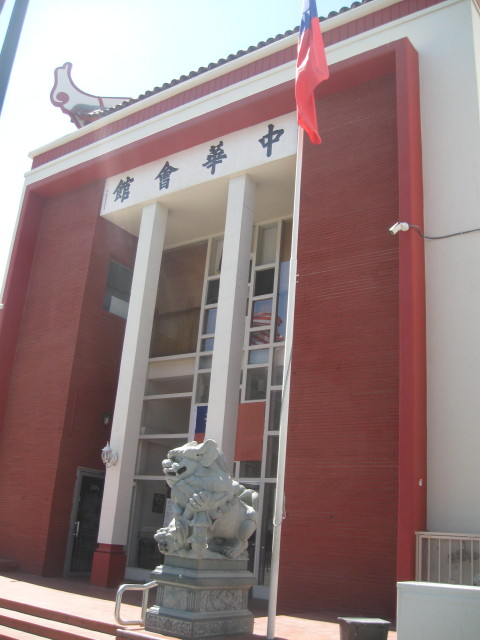
Chinese Consolidated Benevolent
Association
925 N. Broadway
1951, Eugene Kinn Choy &
Associates
Formally organized in 1890, the
Chinese Consolidated Benevolent
Association (CCBA), was formed to
promote and protect Chinese
Americans on both social and
political fronts. It continues to
pursue this mission today,
representing nearly thirty family
and district associations.
The CCBA
relocated to its current home,
designed by Eugene Kinn Choy, in
1951. This unique civic structure
exemplifies the East Eclectic
style of many buildings
commissioned by New Chinatown
businesses and institutions.
The next stop
was a sweet one.
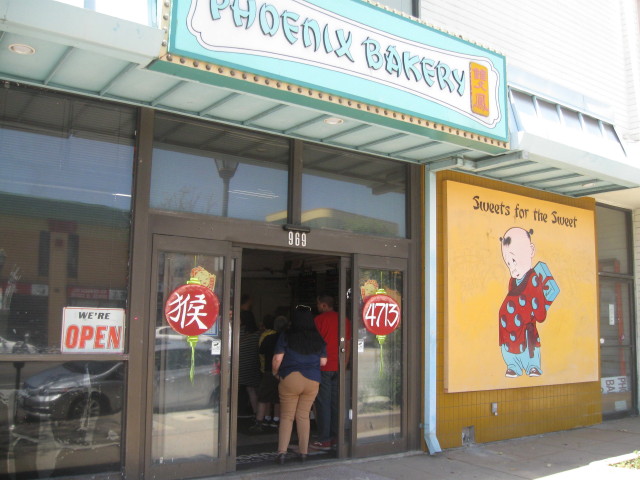
Phoenix Bakery
969 N. Broadway
1977, Gilbert L. Leong
The Phoenix Bakery opened on
New Chinatown's Central Plaza
in 1938. It originally
supplied the community with
Chinese pastries that were
difficult to come by in the
U.S. The logo of a boy
hiding a pastry box behind his
back was created in the 1940's
by Tyrus Wong, who also
painted the Central Plaza's
dragon mural: the logo was
modeled after one of the
children in the extended
family of bakery owner Fung
Chow Chan. With more business
than it could now manage, the
bakery opened its current
location in 1977. Still owned
and operated by
third-generation Chans, the
Phoenix Bakery continues to
produce hundreds of its
trademark whipped cream and
fresh strawberry cakes every
week.
Across Broadway at 970
N. Broadway is the Mandarin Plaza. As I
was running short of time I didn't visit
this site. It was now time to return to my
duty site and check in at the Gee How Oak
Tin Association, 421 Bernard Street. Also
on Bernard Street are two homes next to
the Association.
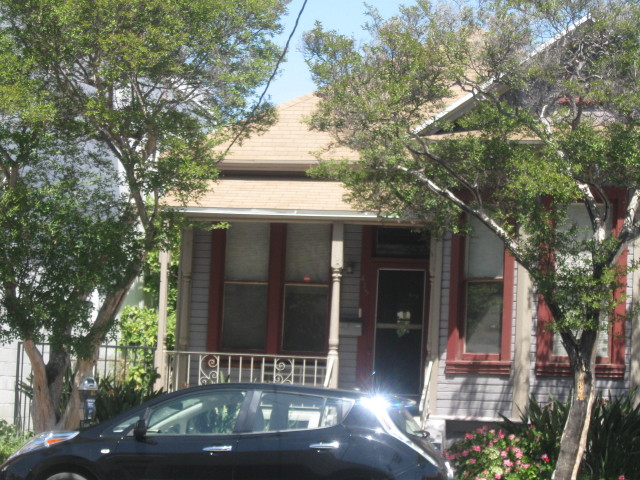
415 Bernard Street.
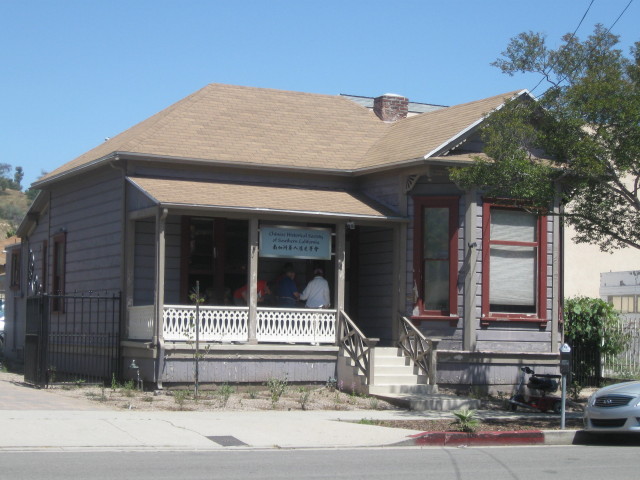
411 Bernard Street.
Chinatown Heritage and Visitors Center.
These two working-class homes harken
back to Los Angeles' early
development. The one-story frame
cottages are rare surviving examples
of the type of residences that once
made up the neighborhood.
Distinctive features such as roofs
with shallow eaves, decorated
gables, simple porches, and wood
clapboard siding exemplify the Queen
Anne Style of the late nineteenth
century. The homes were built by
Alsatian immigrant Philip Fritz, a
carpenter for the Bridges and
Buildings Department of the Southern
Pacific Railroad.
There were
three houses constructed on adjacent
lots over a seven year period;
411 Bernard (which now houses the
Chinatown Heritage and Visitors
Center) was the first built, in
1886. A second house was built in
1888, but was moved to another
location in the 1930s due to street
widening, and has since been
demolished. 415 was built in 1892.
The three homes were often rented to
railroad workers when not being used
by the family. Philip Fritz' three
children and their families lived in
the homes at various times. Philip
Fritz' granddaughter, Louise, was
living in this house, (411) until
her death at 101 in 1992.
Currently
owned by the Chinese Historical
Society of Southern California, the
buildings house a research
collection, bookstore, artifacts,
and displays related to local and
national Chinese and Asian American
history.
Now it was time to
check in with the site captain at the Gee
How Oak Tin Association, 421 Bernard
Street where I was assigned to welcome
tour goers to the second floor main common
room area.
In the nineteenth
century, Chinese men in Los Angele
created a number of family associations
to provide support, protection, and
social ties within the community. With
discriminatory immigration laws severely
limiting Chinese women's ability to
immigrate, the associations offered
meals, healthcare, and camaraderie for
immigrant men working in a strange new
country.
Formed around
surnames identifying common lineage,
family associations offered new
immigrants assistance with job
placement, housing, English lessons,
financial counsel, and funeral services.
They also offered the opportunity to
connect with fellow countrymen through
activities ranging from mahjong games to
charity work.
The Gee How Oak
Tin Association is one of approximately
forty family associations in L.A.'s
Chinatown that continue to serve the
local population as well as new arrivals
from China and Southeast Asia. Inside
the Association building's common room
hangs a picture of the ancestor believed
to be the common link to the various
families that make up Gee How Oak Tin:
the Chans, Chens, Chins, Trans, Woos and
Yuens. Photos documenting multiple
generations of these families ring the
walls. Gee How Oak Tin (meaning "Most
Filial") is an international
organization, and, according to its
members. one of the largest in the
United States. The L.A. Chinatown
chapter comprises 400 to 500
members-including women, who were
officially allowed to join more than a
decade ago.
This building
was built in 1949 for and by the
Association and was deigned by Eugene
Kinn Choy, an important Chinese American
Architect.
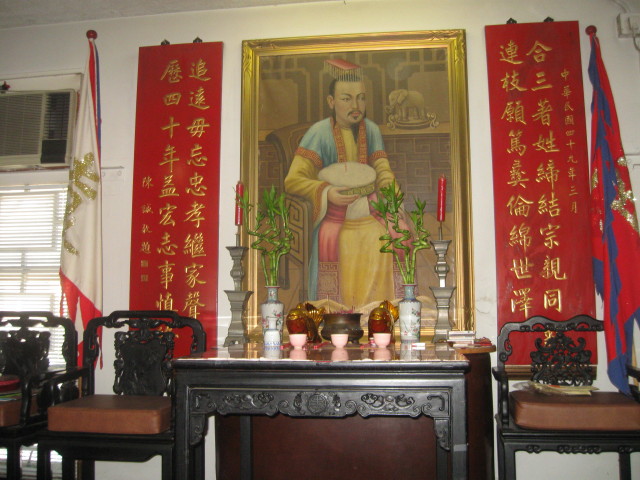
Emperor Shun, circa 2318 B.C., who was a descendant
of Huang-Ti, the "Yellow Emperor" of Ancient China
(3000 B.C.).
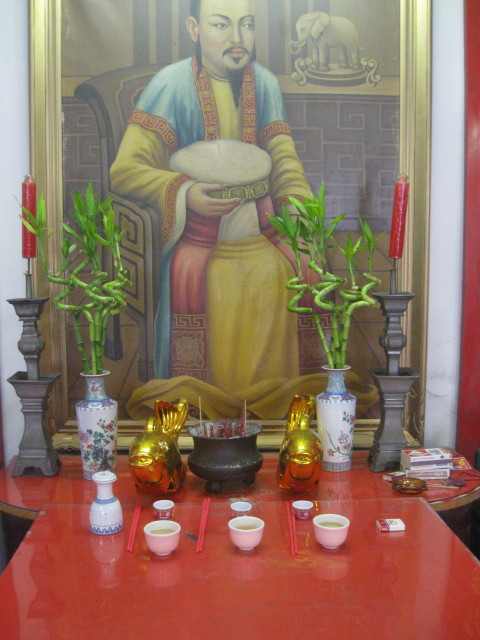
Offering for association's members common ancestor.
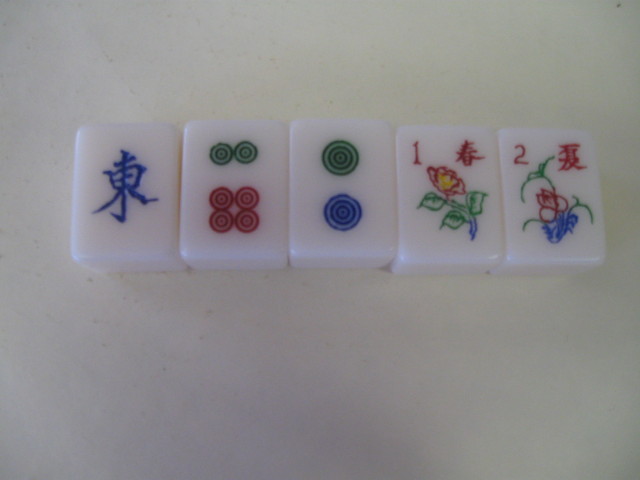
A few mahjong game pieces.
I had a great
time welcoming tour goers plus getting help from
association's members that were on hand to answer
questions and talk more about the Association and
the decorations. I met many people including a
fellow Fullerton meet up train rider and photo
travel writer Carl Morrison. He was taking the
tour with several friends and having an enjoyable
time learning about Chinatown.
Soon it was 4:30 PM and time to
close up. Reports were that the tour was a big
success. Over 800 people were learning about and
enjoying Chinatown. They were looking, buying, and
eating everywhere. A happy time was had by all.
Leaving 421 Bernard Street, I
walked down Broadway heading for the Gold Line
Chinatown station. Walking past the Central Plaza,
I was spotted by Bruce S., who asked me if I had
seen the inside of the Y. C. Hong Office Building.
I hadn't but wanted to, Bruce said I could join
one of the last tours of the building. As this was
a NO photography allowed building I have no inside
photos.
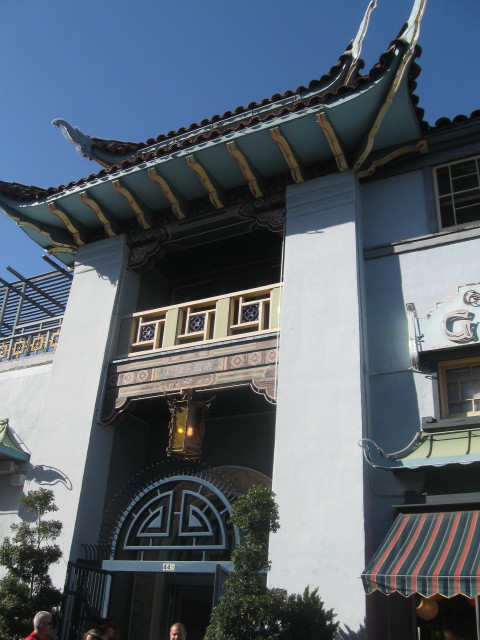
Y. C. Hong Office Building
445 N. Gin Ling Way
1939, Webster & Wilson
Carved
brackets and rafter tails, Chinese-influenced
ornamentation, and a neon silhouette makes
this building a prime example of the East Asia
Eclectic style exemplified in New Chinatown's
Central Plaza. Yet the upstairs office of
lawyer You Chung Hong make it truly special.
The son of a Chinese
immigrant who worked on the railroads. Hong
was the first Chinese American to pass the
California Bar exam in 1923 and before he
graduated from USC's law school. He
specialized in immigration law and devoted his
career to Chinese American civil rights, which
led him to testify before the U.S. Senate and
to appear before the U.S. Supreme Court. Hong
worked on thousands of immigration cases,
always championing the Chinese American
population he served. An active member of the
community outside of his professional career,
Hong contributed greatly to New Chinatown. He
served as one of its founders and commissioned
multiple buildings on Gin Ling Way, including
his office building.
The upstairs tour included
the reception area and Mr Hong's corner office
which is almost the way it looked when he used
it. In one of the several rooms included in
the suite was a display by his granddaughter,
Celeste Hong. She remembers her grandfather
and had several pictures of her and her
grandfather. He died when she was around nine
years old. It certainly added to the tour to
have person connected and related to the owner
and builder. Celeste is also a volunteer at
the LAC and I have been on several committees
with her.
The buildings around the
Central Plaza were designed with shops on the
first level and living space above. Brightly
painted facades and clay-tiled roofs gave a
welcoming charm to the neighborhood.
Today, Central Plaza serves
much the same purpose as it did then: shops
and businesses are still owned by many of the
original founding families, and the neon
lights added shortly after the buildings'
completion create a festival feeling at night.
Also at the Plaza are statues of the first
president of the Republic of China, Dr.Sun
Yat-sen, and action star Bruce Lee.
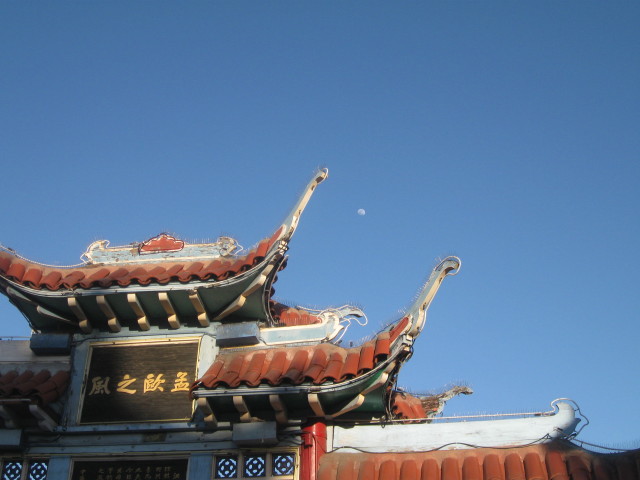
Moon over East Gate.
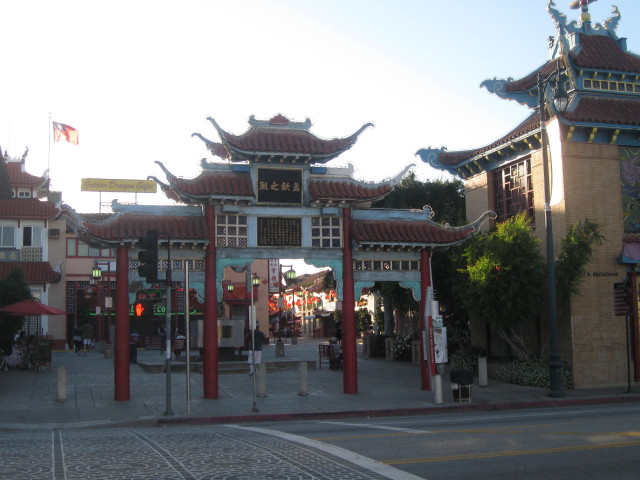
The elaborate East Gate (facing Broadway)
was dedicated on the one-year anniversary of
the Plaza.
Commissioned by Y.C. Hong is honor of his
mother, it is known as the Gate of Maternal
Virtues.
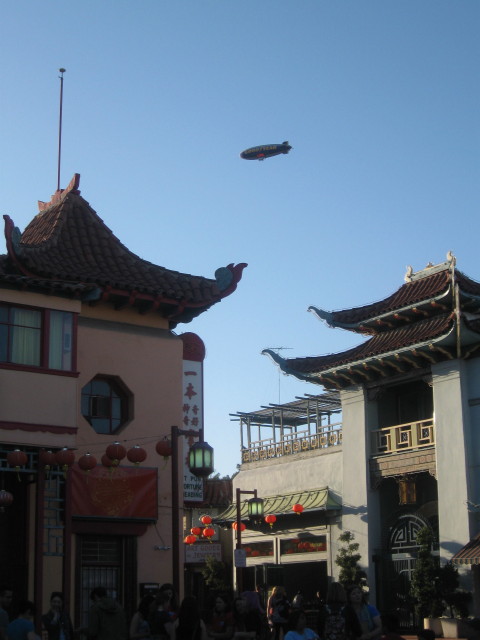
Blimp over Dodger Stadium and the Y.C. Hong
Office Building.
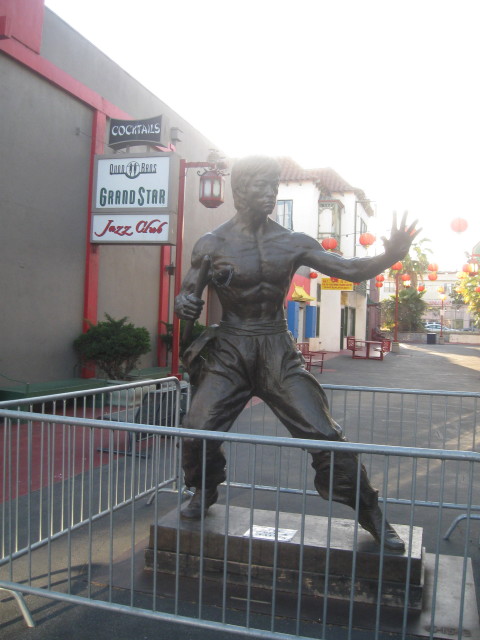
Bruce.
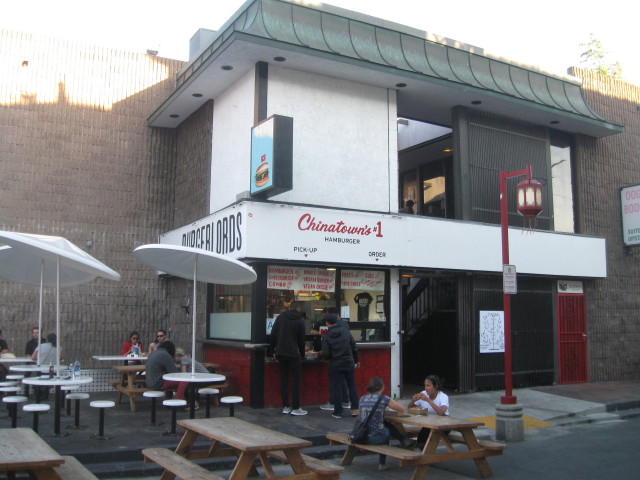
Where I stopped to eat before heading home.
Leaving
Central Plaza, I walked down Broadway to
College Street. At Broadway and College is
located the Bank of America.
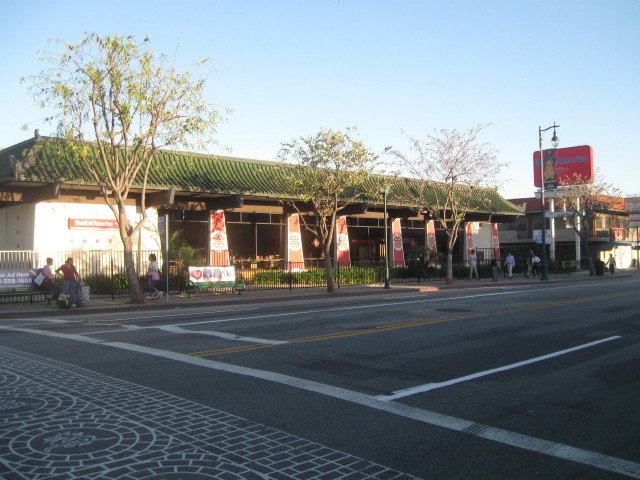
Bank of America
850 N. Broadway
1972, Gilbert Leong and Richard Layne Tom
The
first major national bank to move to
Chinatown, Bank of America decided to open
a branch there only after watching the
success of Chinese-American-owned banks
such as Cathay and East West Bank.
Architect Gilbert L. Leong incorporated
classical Chinese architecture into the
Modern structure through features such as
an imported jade-green tile roof. Leong
built many iconic structures in his
childhood neighborhood, including East
West Bank (where he served as a founding
director), the Kong Chow Family
Association and Temple (931 N. Broadway),
and the the Chinese United Methodist
Church (825 N. Hill Street).
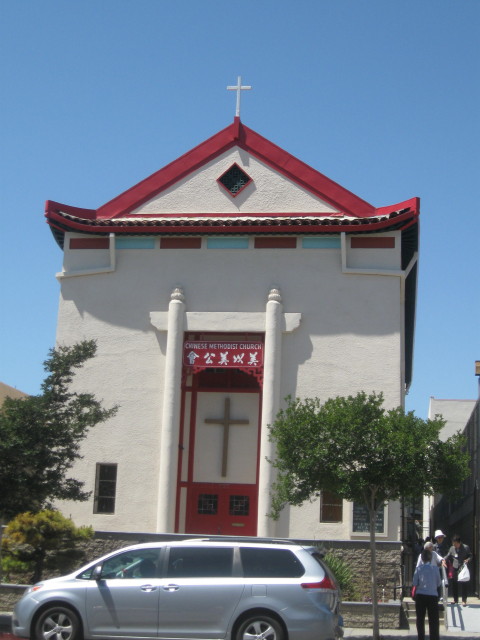
Chinese Methodist Church.
825 N. Hill Street.
Gilbert L. Leong
I
continued downhill on College Street
to the bottom and to the elevator to
whisk me up to the Metro Gold Line
Station platform. On the other
side of the street are the stairs to
the elevated platform. Arriving at
the platform stop, I only had time
for one photo before a rail car was
blocking my view. I could have
stayed and waited for a later train
as I had some time before the
Surfliner left Union Station. Be
sure to tap your metro card before
riding up in the elevator.
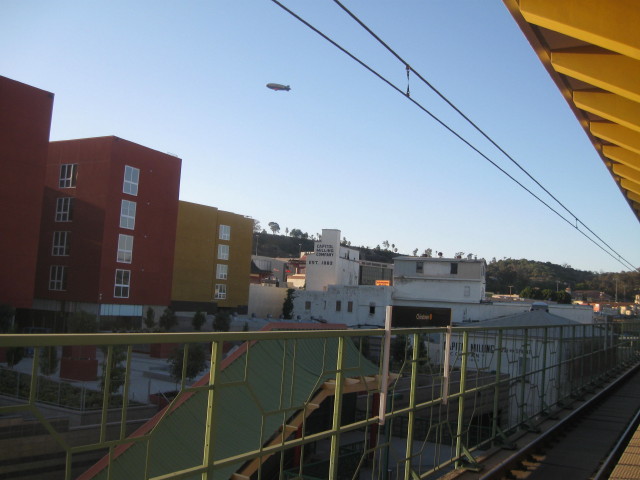
The painted buildings to the left
are part of the Blossom Plaza
project. When completed there will
be a level walkway from the Metro
Station on to Broadway, thereby
eliminating the steep climb up
College Street to Broadway. It
occupies the site of the former
Little Joe's Restaurant, 900 N.
Broadway, 1888, B.J. Reeves.
In 1928, Little
Joe's Italian American Restaurant
was established on the corner of
Broadway and College Street. It
occupied an 1888 building that had
once been a grocery. The business
remained in the Nuccio family,
second-generation owners of the
original grocery until its closure
in 1998. Several years later, the
building was demolished. Now, the
site is home to the Blossom Plaza
project, a $100 million
residential-retail complex that
includes townhouse-style
apartments as well as affordable
housing units.The appealing
five-story buildings were inspired
by Chinese architecture and herald
a revived interest in the
neighborhood.
Before I knew
the history of Chinatown, I always
wondered why there was an Italian
restaurant in the middle of
Chinatown. Now I know.
Capitol Milling
Company
1231 N. Spring Street
1855
1884 addition, Kysor & Morgan
1889 addition, Kysor, Morgan &
Walls
Despite the clearly legible "Est
1883" painted on the side of
Capitol Milling Company's
building, parts of the brick
structure have been standing for
much longer. The brick mill
produced flour from 1855 until
1998, when the company was sold
and the building acquired by San
Antonio Winery. Capitol Milling
harkens back to the agricultural
industry that once flourished in
the area. Los Angeles was still
a rough Mexican outpost of
approximately 800 people when
water from the ditch that
provided early settlers with
water, the Zanja Madre, powered
Capitol Milling's water wheel.
The company (known first as
Eagle Mill, the as Deming Mill)
would eventually be named
Capitol Milling by owners Jacob
Lowe and Herman Levi, German
American Jews who purchased the
mill in 1883. Capitol Milling
stayed in the Levi family until
its closure in 1998, making it
the longest-running family-owned
business in Los Angeles.
It was a very
short ride from Chinatown and Los
Angeles Union Station. The
original Metro plans had no stop
in Chinatown. They neither planed
nor wanted a stop so close to
LAUS. The locals were able
to show Metro the error in their
thinking. Now the Metro Gold Line
Chinatown stop is one of three
stations designated as "landmark"
stops by Metro (in addition to
Southwest Museum and Memorial
Park).
Upon arriving
at LAUS with about three quarters
of a hour till Pacific Surfliner
train 1790 departed, I waited in
the waiting room. A wonderful room
and a great place to people watch.
I was keeping track of the
arrivals and departures boards.
Train 1790 left San Luis Obispo,
CA at 2:00PM with arrival in Los
Angeles at 7:20 PM. The southbound
trains going through Los Angeles
to San Diego, CA tend to be
heavily occupied, and Sunday
afternoons and nights are the
busiest. So I wanted to be on the
platform when the train arrived
and ready to grab a seat. The
census was about 70% filled. The
horn sounded and we were pulling
away from the platform as the
clock struck departure time. After
36 miles and one hour I was
walking in the Santa Ana parking
structure to my auto. A quick trip
on the freeway and I was home.
Web page:
Click
here for the Los Angeles
Conservancy
Click
BACK
button on your browser to
return to this page.
And a
special thanks to the Los Angeles
Conservancy.
Data used
in this report was obtained from
their booklet: Exploring
Chinatown: Past and Present Tour,
April 17, 2016.
The author retains all rights.
No reproductions are allowed
without the author's consent.
Comments are appreciated
at......yr.mmxx@gmail.com
Thanks for reading.

